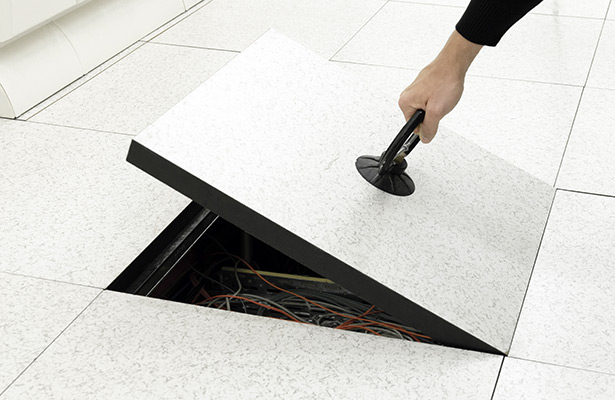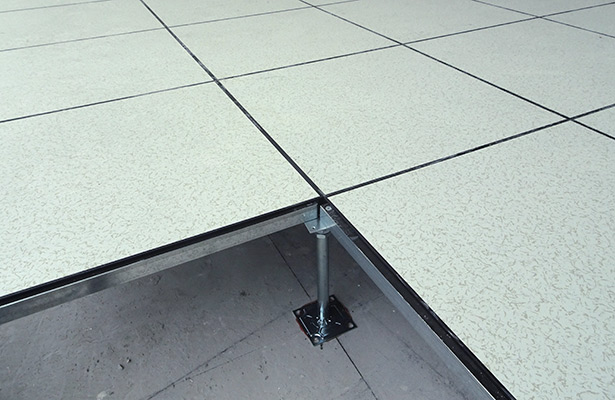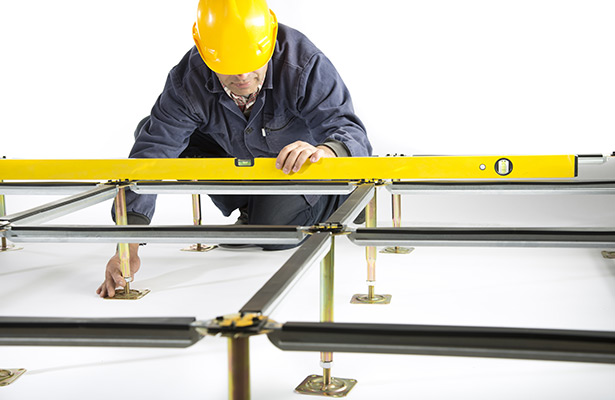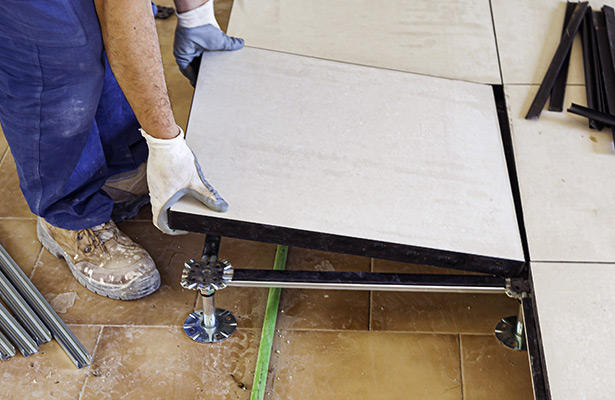Adhesives for manufacturing and assembly of raised floors
Raised floors can be made from a range of different materials such as particle boards, mineral materials, aluminium, steel plates, plastics, carpets, etc. These are joined together to produce the final product and later installed with the aid of metal supports. A variety of adhesives are used during manufacturing and installation.


© amaze646 - stock.adobe.com


© Aisyaqilumar - stock.adobe.com
KLEIBERIT’s portfolio includes many products tailored to the different needs in raised floor manufacturing and installation. Dispersion adhesives, two-component systems, reactive and thermoplastic hotmelts all provide high-strength and reliable bonding.
Edge banding in manufacturing raised floor boards
Edge banding protects the open raised floor board. Special edging materials are used to dissipate any electrostatic discharge that may occur. Laminate edges, polyester edges, resined paper edges, and PVC edges are examples of typical edge banding materials. We recommend using EVA hotmelts for efficient production processes. Depending on the combination of materials used, pre-treating with a primer can lead to improved bonding results. EVA dispersions can also be used for edging raised floor boards.
Find the right adhesive for your application.
Take a look at our product table and let our experts advise you.
Adhesives for fitting raised floors
Raised floor boards can be laminated with specific materials, either for aesthetic reasons or to meet the usage requirements. Raised floors must be electrically conductive, washable, waterproof, and suitable for use with wheelchairs. Textile surfaces – whether non-woven or carpet surfaces with or without latex or synthetic backings – all need to be glued or bonded in some way. Finding the right adhesive depends on the materials used and the manufacturing process.
Take a look at our product table and let our experts advise you.
Gluing the moisture barrier in raised floor manufacturing
A moisture barrier is applied to the whole underside of the raised floor in order to prevent any moisture seeping into the board from below. This ensures a stable and even surface over the long-term without changes to the properties. The adhesive has to be permanently resistant to heat sources and moisture seeping in to the glued joints. Reactive hotmelts are increasingly becoming the product of choice for such purposes.
Take a look at our product table and let our experts advise you.


© uwimages - stock.adobe.com


© peuceta - stock.adobe.com
A range of different adhesives are used for installing raised floors. Glues are used to lock threads and fix supports, and special dispersons are used to carry out sealing work on screed.
Thread locking with 1C adhesives
Raised floor boards are installed on a structure of frames and supports, with threaded rods being used to adjust the height of the supports. Over time, the height of the threaded rod can change due to constant pressure being applied to the floor, leading to unevenness. To prevent this, thread locking adhesives are used to connect the threaded rod to its position so that it stays in place and the height remains the same.
Take a look at our product table and let our experts advise you.
Gluing supports with 1C adhesives
Raised floor supports are glued to the subfloor to prevent them from moving during the course of use. We recommend using two-component PUR adhesives for this purpose: they can be configured to the user’s exact needs, and are fast and easy to mix in the required amounts on site.
Take a look at our product table and let our experts advise you.
Sealing the subfloor with an acrylate dispersion
A sealant can be applied to improve the subfloor and also to bind dust particles. This additionally creates an ideal basis for bonding the supports. The sealant is applied in a thin layer and waterproofs the surface of the foundation. It does not, however, even out any irregularities in the floor.
Any questions? Take a look at our product table and let our experts advise you.
Product for on-site assembly of raised floors
Product | Base | Certificate | Applications |
|---|---|---|---|
473.0.00 | acrylate dispersion | GEV-Emicode EC1 plus | Floor primer for dust binding |
504.0.00 | 1C PUR |
| Thread lock on the supports |
539.5.00 | 2C PUR |
| Pedestal adhesive for clean rooms |
566.0.00 | 1C PUR |
| Pedestal adhesive (general, not for clean rooms) |
Adhesives for flat lamination of raised floors
| Product | Base | Certificate | Adhesive properties | Applications | ||
|---|---|---|---|---|---|---|
| non-conductive | conductive | |||||
| 404.3.00 | EVA dispersion | GEV-Emicode EC1 plus | • | Bonding of elastic coverings on chipboards, dyed grey | ||
| 404.4.00 | EVA dispersion | GEV-Emicode EC1 plus | • | Bonding of elastic coverings on calcium sulfate boards, dyed grey | ||
| 404.6.00 | VA/E copolymer | IMO certified | • | Bonding of carpets and plastic coverings, dyed black | ||
| 404.8.00 | VA/E copolymer | GEV-Emicode EC1 plus | • | Bonding of carpets and plastic coverings, dyed grey | ||
| 405.3.00 | synthetic resin dispersion | • | Bonding galvanized steel sheets and aluminium foil moisture barriers | |||
| 405.5.00 | synthetic resin dispersion | GEV-Emicode EC1 plus | • | Bonding of galvanized steel sheets | ||
| 466.0.00 | VA/E copolymer | • | Bonding of plastic coverings and aluminum foil moisture barriers | |||
| 596.1.00/596.2.00 | 2C PUR | GEV-Emicode EC1 | • | Bonding of carpets / plastic coverings and galvanized steel sheets | ||
| 596.3 + 870.0 | 2C PUR | GEV-Emicode EC1 plus | • | Adhesive for high-strength bonding of metal, plastics and wooden material, also suitable for carpet bonding | ||
| 596.6.00 | 2C PUR | IMO certified | • | Bonding of plastic coverings and galvanized steel sheets | ||
Adhesives for edgebanding of raised floors
Product | Base | Adhesive suitable for … | Applications | ||
|---|---|---|---|---|---|
| non-conductive, gypsum fibre board | non-conductive chipboard | conductive chipboard | |||
707.6.00 | PUR HM |
| • | Bonding of plastic and paper edges | |
728.7.00 | PSA | • |
| Bonding of plastic and paper edges | |
771.2.00 | EVA copolymers |
|
| • | Conductive product for bonding of plastic and paper edges |
777.0.00/.2.00/.4.00 | EVA copolymers |
| • | Bonding of plastic and paper edges | |
779.7.00 | EVA copolymers |
| • | Bonding of plastic and paper edges | |
788.3.00 | EVA copolymers | • | • | Bonding of plastic and paper edges | |
Primer for edgebanding of raised floors
Product | Base | Primer suitable for … | Applications | ||
|---|---|---|---|---|---|
| non-conductive, gypsum fibre board | non-conductive chipboard | conductive chipboard | |||
555.6.00 | 1C PUR | • | • | • | Edge improvement of chipboard and gypsum fibre board |
837.0.00 | artificial resin/solvent | • | • | • | Edge improvement of chipboard and gypsum fibre board |




